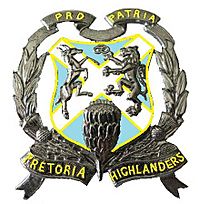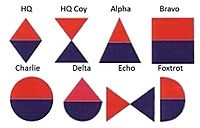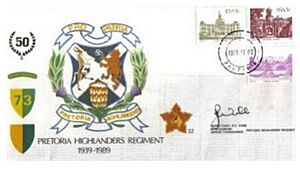Pretoria Highlanders facts for kids
Quick facts for kids Pretoria Highlanders Regiment |
|
|---|---|

SANDF Pretoria Highlanders emblem
|
|
| Active | 1939 to 4 June 2017 |
| Country | |
| Allegiance | |
| Branch | |
| Type | Reserve Artillery |
| Size | Battery |
| Part of | South African Army Artillery Formation Army Conventional Reserve |
| Nickname(s) | Jacaranda Jocks |
| Disbanded | 4 June 2017 |
| Insignia | |
| Collar Badge | Bursting grenade with seven flames |
| Beret Colour | Oxford Blue |
| Artillery Battery Emblems |  |
| Artillery Beret Bar circa 1992 |  |
The Pretoria Highlanders Regiment was a special military group, or regiment, in the South African Army. It was a "reserve unit," which means its members were not full-time soldiers. They were like part-time soldiers who could be called upon when needed. This is similar to the Army Reserve in the United Kingdom or the Army National Guard in the United States.
Even though the regiment itself was officially closed down, its amazing pipe band is still active today!
Contents
History of the Regiment
How the Regiment Started
The Pretoria Highlanders Regiment began in 1939. This was when World War II started. A person named Peter Lawrence Goudie created the regiment.
He quickly found 1,400 men to join in just six weeks. He also raised money to buy them special uniforms. These uniforms were like those worn by traditional Scottish Highland soldiers.
World War II Adventures
During World War II, the regiment was part of the 7 South African Infantry Brigade. They took part in a secret mission called "Operation Rose." This mission was an invasion of Madagascar in June 1942.
This was a very special operation. It was an amphibious operation. This means soldiers traveled by sea and then landed on the shore to fight. It's believed to be the first and only time South African troops did this kind of landing.
Changes After the War
After World War II, in 1946, the Pretoria Highlanders changed. They became an artillery unit. Artillery units use large guns to fire shells. They were renamed 1 Anti-Tank Regiment (PH).
In 1960, the army changed again. The regiment became an armoured unit. Armoured units use tanks and other armored vehicles. They went back to their original name, Pretoria Highlanders.
The regiment was then part of the 7th Division's 73 Motorised Brigade.
The Pipe Band
A band was first formed around the same time the regiment started. The modern Pretoria Highlanders Pipes and Drums band began in 1979.
The band was stopped in 2005. At that time, it didn't get any official support from the defense force. But the band was started up again! Their first new gathering was on April 13, 2013.
Leaders of the Regiment
- Cmdt Henk Kaal was one of the officers who commanded the regiment.
Regimental Symbols and Uniforms
The Pretoria Highlanders had special symbols and uniforms. These helped them show who they were.
- Uniform Details
- Headdress: They wore a khaki Tam O'Shanter or a black glengarry. These are types of Scottish hats. Both hats had a bottle green "Tourie," which is a small pom-pom on top.
- Tartan: They wore kilts made from the Hunting Stewart tartan pattern. A kilt is a type of skirt worn by men, especially in Scotland. Their sporran, a small pouch worn with a kilt, was brown leather for everyday wear. It was silver or grey-haired for formal occasions.
- Hose: These are long socks. They were khaki in color. The tops of the socks had the regimental tartan pattern. They also wore green garter flashes, which are decorative ribbons.
- Nickname: The regiment was known as the "Jacaranda Jocks." This is because Pretoria is famous for its beautiful jacaranda trees. The trees bloom with purple flowers.
Old Uniform Badges
Special Honors
The regiment earned a "battle honour" for its part in the World War II invasion of Madagascar.
- Madagascar 1942



